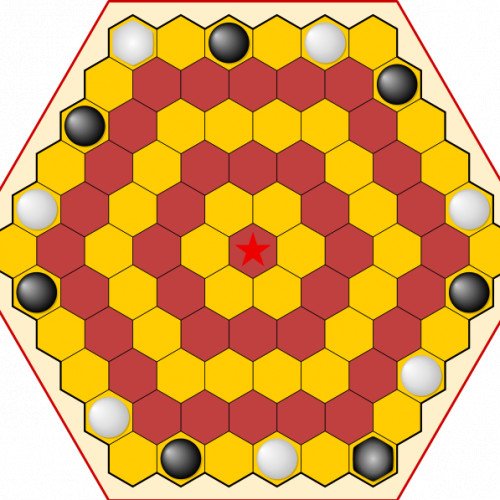AGON VS SUFFRAGETTO

AGON
Agon (or Queen's Guards or Royal Guards) is an strategy game invented by Anthony Peacock of London, and first published in 1842. It is a two player game played on a 6×6×6 hexagonal gameboard, and is notable for being the oldest known board game played on a board of hexagonal cells. Each player has one queen and six guards. Players determine who moves first, then turns alternate. On each turn, a player moves one of his pieces. The object of the game is to be first to maneuver one's queen to the central hex (the throne) at the center of the board, and surround her with all six of her guards. The gameboard may be thought of as a series of concentric rings of hex cells (highlighted by rings of alternating colors). Pieces move one step at a time to an adjacent cell, either sideways in the same ring, or towards the throne to the next ring. The cell moved to must be vacant. Only the queen may move to the throne.
Statistics for this Xoptio

SUFFRAGETTO
Suffragetto was a board game published in the United Kingdom around 1908 by the Women's Social and Political Union (WSPU) and manufactured by Sargeant Bros. Ltd. In modern terms, it was developed to "enact feminist ideology in a hybrid fantasy-real world environment" to support the activist strategies of the suffragettes. The game is a contest of occupation featuring two players around a grid board representing the streets of Edwardian London. One player plays 21 green markers as the radical suffragettes, the other player plays 21 dark blue markers as the police constables. The objective of the suffragettes is to break through police lines and enter the House of Commons, while at the same time preventing the police from entering Albert Hall. The objective of the police is to disrupt the meeting of the suffragettes by entering Albert Hall, while at the same time preventing them from entering the House of Commons. "Arrested" suffragettes are confined to the "prison" section of the board, whereas "disabled" constables are confined to the "hospital" section. The game is won by the first player who introduces six markers into the opponent's base. The WSPU were enthusiastic about manufacturing and selling the game, as it would allow the organisation to continue running without having to depend on donations from wealthy individuals. Oxford's Bodleian Libraries has the only known surviving copy of the game. Suffragetto was among several children's games designed at that time around the themes of gender, resistance, and social relationships, along with the contemporaneous games Panko and Pank-a-Squith (1909). The goal of the latter was to navigate a suffragette (led by Emmeline Pankhurst) down a long path from her home to parliament, past obstacles placed by the Liberal government (led by Prime Minister H. H. Asquith).